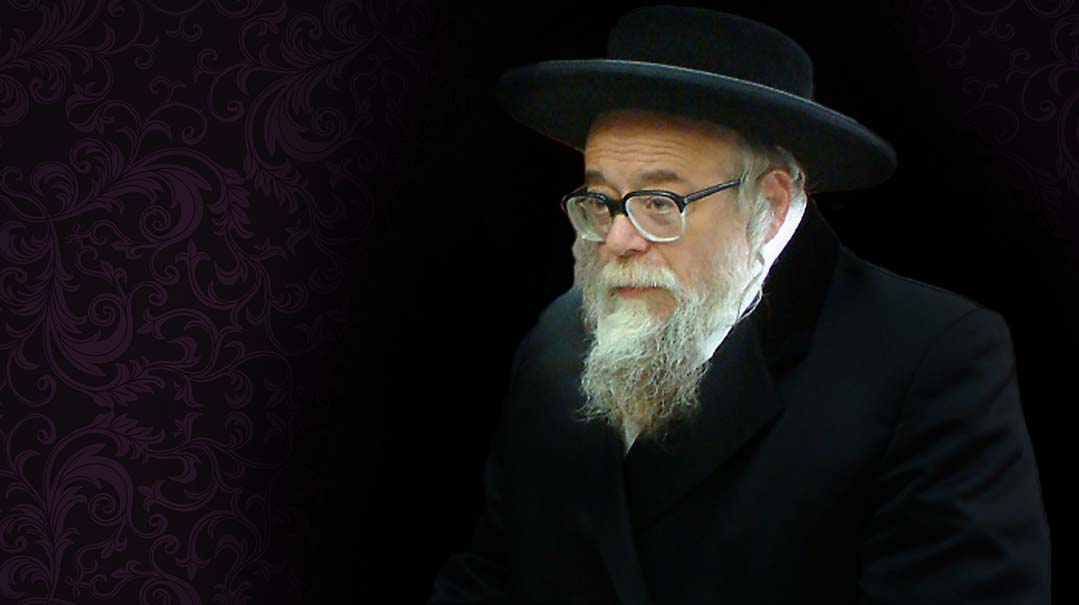No Other Answer
| August 31, 2021For the Toldos Aharon Rebbe, faith begins where intellect ends

Sometimes the loss is so devastating that it defies comprehension. And yet within the excruciating pain, understanding dawns from the depths of the neshamah — that in truth, we really don’t understand anything. That’s the gift of emunah, the knowledge that Hashem is in charge and in control. The Toldos Aharon Rebbe, who has returned to the days of hiding out undisturbed, is busy pulling down that light
There was nothing to say. Nothing that could be said. Because sometimes words aren’t necessary, or even needed.
The two men stood there, Rabbi Avigdor Chayut bending toward the Toldos Aharon Rebbe, who stood in place, swaying slightly.
Reb Avigdor lost his son Yedidya and his talmid Moshe Levy in Meron this Lag B’omer, and in the time since, his public appearances have made him a symbol of unwavering emunah in the face of unfathomable pain.
“I want to thank the Rebbe,” he said, as the Rebbe looked at him quizzically.
“Rebbe, every day we hear about people who lose their lives in all kinds of incidents and tragic situations, and it often feels so stam, so random,” he explained. “People are taken suddenly, in the middle of a trip or doing something mundane. Yet Yedidya and my beloved talmid Moshe left This World when they were at the pinnacle of dveikus to HaKadosh Baruch Hu, as they said pesukim of emunah and Yichud Hashem, as they were mekabel ol malchus Shamayim,” Rabbi Chayut says.
He was referring to the end of the Toldos Aharon Rebbe’s hadlakah, minutes before the tragedy occurred. (The Toldos Aharon hadlakah is usually held at shkiyah as the day of Lag B’omer wanes, the final dramatic minutes of the holy day when tears are shed and final prayers offered. This last year, because Lag B’omer fell out on Friday, the famed hadlakah was advanced to Thursday night and that meant the crowd swelled.)
The Rebbe, pain lining his face, knowing that the fatal crush happened minutes after thousands of men and boys left the site of the hadlakah, nodded. “Your words give chizuk,” he said.
The two of them were standing in the woods near the kever of Rabi Shimon, not far from the site of the tragedy, silence draped over them like a blanket — the first visit since Lag B’omer for both of them.
“It was important for me to connect to the Rebbe personally on this,” Rabbi Chayut later tells Mishpacha. “As believing Jews, none of us has a doubt that this was what was decreed from Above, and this is what was supposed to happen. But within this gezeirah we merited a wonderful gift — that the yetzias haneshamah of these 45 holy souls occurred amidst dveikus to Hashem, just like Rabi Akiva, the rebbi of Rashbi, whose holy soul departed with the word ‘echad.’ After singing Ani Ma’amin and reciting ‘Hashem Hu Ha’Elokim’ seven times, these Jews, my son Yedidya and my student Moshe among them, merited to pass away in a way that was experienced by special and holy individuals through the generations. You know, that night, there was a similar crush an hour and a half earlier and no one was hurt. It’s clear to me that these neshamos were selected to rise to the Heichal Rashbi a few moments after kabbalas ol malchus Shamayim. I have no doubt of it.”
As they parted from each other, the Rebbe thanked Rabbi Chayut again and offered more words of comfort, then they made a l’chayim in honor of the 45 kedoshim. The brachah of Shehakol nihiyeh bidvaro that echoed through the forest was eerily significant.
“L’chayim. Tovim. U’leshalom,” the Rebbe said, no longer holding his tears in check.
Oops! We could not locate your form.







